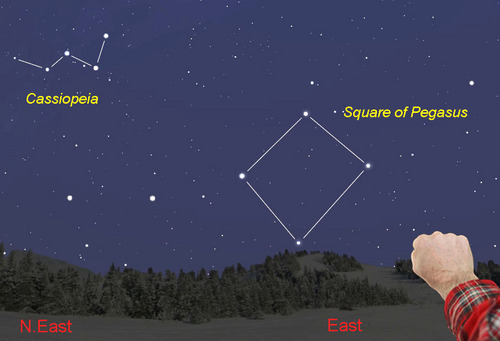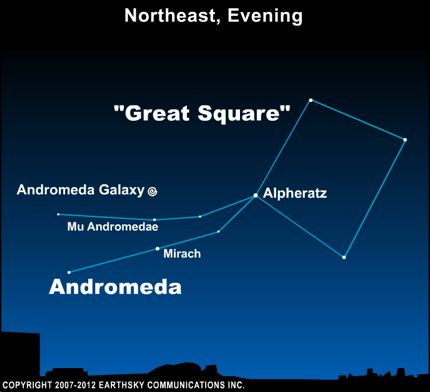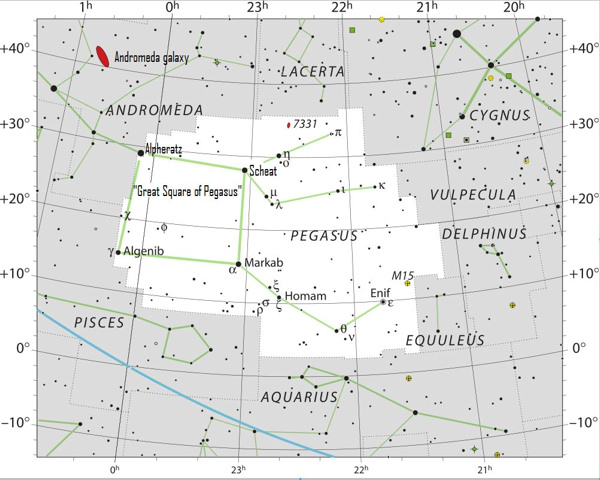

The Great Square of Pegasus consists of 4 stars of nearly equal brightness: Scheat, Alpheratz, Markab and Algenib. Illustration via AstroBob.
The Great Square of Pegasus gallops into the fall sky just after dark around the September equinox, which fells in 2019 on September 23. It consists of four stars of nearly equal brightness: Scheat, Alpheratz, Markab and Algenib. It’s a landmark of the Northern Hemisphere’s autumn sky.
To find it, first of all use the Big Dipper to star-hop to Polaris the North Star. By drawing an imaginary line from any Big Dipper handle star through Polaris, and going twice the distance, you’ll always land on the W or M-shaped constellation Cassiopeia the Queen. A line from Polaris through the star Caph of Cassiopeia faithfully escorts you to the Great Square of Pegasus.

Image via astrobob.

Finding the Great Square of Pegasus.
Like the Big Dipper, the Great Square of Pegasus isn’t a constellation. Instead, it’s an asterism, or noticeable pattern on our sky’s dome.
The Great Square is used much like the Big Dipper to help you find other sky treasures, the most notable being the Andromeda Galaxy.

Use the Great Square of Pegasus to find the Andromeda galaxy. Here’s how to do it.
A great big square of nothing. Often at events where many are stargazing for the first time, one may hear:
… the Great Square has nothing in it.
But, of course, the Great Square isn’t empty. The stars in the Square are faint enough that the unaided eye can’t easily detect them. If you have binoculars or small telescopes many stars pop up within the Square.

View larger. | You often hear people say the Great Square is “empty” of stars. Of course, it’s not. Charles White created this composite on November 20, 2017. It consists of 10 images, each a 30-second exposure. Rokinon 35mm lens, f2.0 ISA1600. Camera: Sony QX1 ILCE. Iptron Sky Tracker.
One of the most famous faint stars near the Great Square is 51 Pegasi. In 1995 astronomers announced they discovered a planet around this star. After a few months of skepticism from the astronomical community, it was confirmed that the first planet outside of our solar system had been discovered. Now we know that two planets orbit the star.
Some books say that 51 Pegasi can be viewed with the eye alone, but it’s a bit of a challenge. Using binoculars, look roughly halfway between Scheat and Markab. The chart below is courtesy of Professor Jim Kaler. Note that you won’t be able to see the planets. Pegasus 51 is approximately 50 light-years away from Earth.

The star 51 Pegasi in the Great Square, via Jim Kaler.
You might recall that Pegasus was a winged horse in Greek mythology. The constellation Pegasus is one of seven constellations in the sky that tell why it is not good to say that a mortal is more beautiful than the gods. This story is plastered all over the autumn night sky.
Queen Cassiopeia bragged that she (or her daughter Andromeda) was more beautiful than the immortal Nereids, or sea nymphs. This angered the gods, who asked the sea-god Poseidon to take revenge. The punishment was that King Cepheus and the Queen had to sacrifice their only daughter Andromeda to Cetus the sea monster. Andromeda, chained down to a rock at sea, and about to be gobbled up by the sea monster, saw Perseus riding Pegasus the flying horse. Perseus swooped down and showed the head of the Gorgon Medusa to Cetus, the sea monster, instantly turning Cetus to stone. Then Perseus whacked off the chains holding Andromeda and freed her.
They flew off into the sunset to live happily ever after. The mortal horse on the last day of his life was given the honor of becoming a constellation for his loyal service. The dolphin that provided comfort to Andromeda was also granted immortality in the heavens by Zeus with the Delphinus constellation.
Enjoying EarthSky so far? Sign up for our free daily newsletter today!
Donate to EarthSky: Your support means the world to us

The Great Square of Pegasus makes up the eastern (left) half of the constellation Pegasus. Image via Wikimedia Commons
Bottom line: How to see the Great Square of Pegasus star pattern.
Source:
https://earthsky.org/favorite-star-patterns/great-square-of-pegasus-wings-in-sept-equinox